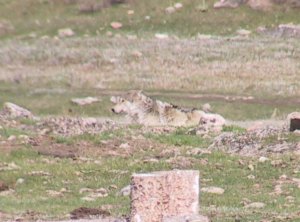President Obama will sign the bill into law and wolves will no longer enjoy the protection of the Endangered Species Act.
The House and Senate passed a budget bill which included the rider to delist wolves in Idaho, Montana and parts of Oregon, Washington, and Utah but leaves the status of wolves in Wyoming unchanged. The rider, attached by Senator Jon Tester (D-Montana) and Representative Mike Simpson (R-Idaho), mandates that the Secretary of Interior republish the 2009 delisting rule in the Federal Register within 60 days of passage of the bill and restricts the rule from being challenged in court.
President Obama is expected to sign the bill.
The removal of a species from the Endangered Species Act by Congress is an unprecedented move and is likely to be followed by more such moves in the future. Congress has basically said that if a species becomes too inconvenient to industry then it shouldn’t be allowed protection and management of the species doesn’t have to subject to the best available science.
What comes next is anyone’s guess but surely there will be a great number of wolves killed in Idaho and Montana in areas where their respective game agencies have blamed wolves for declined elk populations. Those killings could begin immediately after the rule is published in the Federal Register and if they occur soon then they will undoubtably end up killing packs of wolves who are near their den sites. Idaho has committed to maintain only 10-15 breeding pairs or 100-150 wolves in total and they recently passed a wolf disaster declaration which defines a wolf disaster as having any more than 100. Even though that legislation is now moot because it only applied while wolves were not protected under the ESA, it is a signal of things to come from the legislature next year.
One thing should become abundantly clear. The livestock industry, with the help of Democrats, did this. If anyone thinks that Democrats represent the interests of wildlife advocates or that the livestock industry presents anything other than a threat to wildlife then they are fooling themselves. Now that you recognize this what do you do? Do you hold them accountable? Do you escape from your codependent behavior that so many of us used to avoid conflict with our families and understand that it is effective politically? Really, this happened because the anti-wolf crowd was able to rile up people into a fervor using hyperbole and fear that was noticed by politicians who are only worried about their reelection. That’s how politics works. The squeaky wheel gets the grease.
At least one group is already blaming the non-settling groups for taking away “leverage to rally senators against Tester and Reid” even though the judge specifically pointed out that he did not have the discretion to “allow what Congress forbids”. Of course I wasn’t pleased with the settlement deal and I don’t think that it would have provided any more protection than what wolves face today but I also don’t think that it is useful to blame anyone other than the people who orchestrated this gutting of the Endangered Species Act. We could have that conversation but what purpose does it serve other than to feed one’s ego?
The real focus should be on making sure that wolves remain on the landscape and serve a meaningful role in the ecosystem and not just a token population that exists at artificially low levels. I suggest that there are a few main targets to make sure this happens. First, defund the Wildlife Services predator control program, they need to be grounded so that they can’t kill wolves from the air. Second, conservationists need to recognize that the livestock industry is who orchestrated this and that they will be more scrutinized now that they have done this. More focus should be placed on public lands ranching that depends so much on the good graces and taxes of the public. And Third, the politicians who take the votes of wildlife advocates need to held to account. Western Democrats worked hand in hand with Republicans and the livestock industry to get this done. They need to know that they will face primary challengers who are willing to scuttle their entire candidacy just to make the point.
Does the metaphorical Hayduke live? I’m not so sure anymore. Can he be resurrected? I hope so. As conservationists we have to give them hell.



 Location
Location


